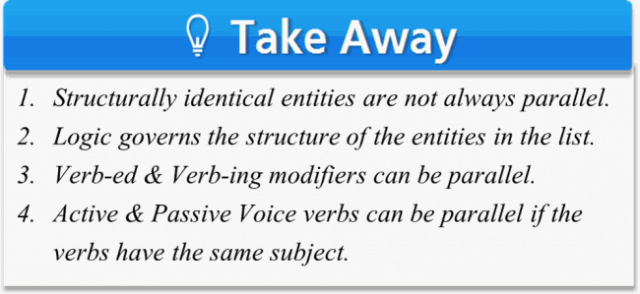PARALLELISM: IMPERFECT LIST
Scientists have recently discovered what could be the largest and oldest living organism on Earth, a giant fungus that is an interwoven filigree of mushrooms and rootlike tentacles spawned by a single fertilized spore some 10,000 years ago and
extending for more than 30 acres in the soil of a Michigan forest.
A. extending
B. extends
C. extended
D. it extended
E. is extending
This is Q#42 from OG 12. It has been removed from OG 13. So if you want to solve this question first, go ahead. But my belief is that most of you have already solved this question before and will not forget the confusion it had created when you encountered it for the first time. This question can safely be said to be one the most confusing and extensively discussed official questions. Reason: The seemingly “non-parallel” grammatical structure of the entities. We classify the list as Imperfect List.

The OA for this one is choice A. Did you ask, “Hey, “spawned” and “extending” are parallel? They don’t even look grammatically similar.”
This reminds me of a similar question that we are always asked. “Can active voice be parallel to passive voice?” The answer to all these questions is “Yes”. “Spawned” is parallel to “extending” and active and passive voices can also be parallel, another instance of Imperfect List.
A LITTLE TWEAK
Logic and grammar run parallel in parallelism. Entities in a list must be Logically as well as Grammatically parallel. Many a times, it becomes difficult to maintain identical grammatical structure to convey the logical intended meaning. In these scenarios, the grammatical structures are not compromised but tweaked a bit to maintain logic in the sentence. Overall, logic trumps grammar. After all grammar is a tool to express logic!! (or shall I say intended meaning).

This tweak results in Imperfect List where we see apparently “non-parallel” grammatical entities such as “spawned” and “extending”, active and passive voice entities, etc. Here are some structures of possible imperfect lists:
1. Active and passive voice entities
2. Verb-ed and Verb-ing modifiers
Reference Article: Here is another article that you may want to refer to. Also, check out our concepts on parallelism for more explanations.
Registerat
e-gmat for the same.
https://gmatclub.com/forum/parallelism-g ... 41946.htmlSIMPLE IMPERFECT LIST
Let’s take a few simple examples before analyzing the confusing OG problems. Look at these five example sentences below and mark the sentences that parallel. (You will need a pen and paper for that )
1. The new lamp decorated with pink flowers and resembling a star brought a large smile on the child’s face.
2. The new lamp decorated with pink flowers and resembled a star brought a large smile on the child’s face.
3. The new lamp decorating with pink flowers and resembling a star brought a large smile on the child’s face.
4. The new lamp decorated with pink flowers and that resembles a star brought a large smile on the child’s face.
5. The new lamp that is decorated with pink flowers and that resembles a star brought a large smile on the child’s face.
EXPLANATION
Let’s analyze one sentence at a time.
1. The new lamp
decorated with pink flowers and
resembling a star brought a large smile on the child’s face.
This sentence is about a new lamp that made a child smile. Two characteristics of this lamp are mentioned here. The new lamp:
a. is decorated with pink flower and
b. resembles a star.
Notice that “decorated” is the verb-ed modifier presenting one quality of the lamp. “resembling” is a verb-ing modifier presenting another quality of the lamp. So, both these words are modifiers that perform the same function. Hence, “decorated” and “resembling” are parallel. Yes, one is a Verb-ed Modifier and the other is Verb-ing Modifier. But they both are “Modifiers” and modify the same entity. This is the reason why these two are parallel.
2. The new lamp
decorated with pink flowers and
resembled a star brought a large smile on the child’s face.
In this sentence, “decorated” and “resembled” are structurally identical but not parallel. “Decorated” is a verb-ed modifier but “resembled” is a simple past tense verb. They do not perform the same function. Hence, they are not parallel.
Also notice that now “The new lamp” has two verbs “resembled” and “brought” that are not connected properly. So this sentence is INCORRECT.
3. The new lamp
decorating with pink flowers and
resembling a star brought a large smile on the child’s face.
Here too, “decorating” and “resembling” are structurally identical but not parallel. The phrase “decorating with flowers” seems to suggest that the lamp was doing the action of decorating. Moreover, “decorating” by itself cannot be a continuous verb because it is not preceded by any helping verb (is/am/are/was/were). So, even if they look identical, these two entities are not parallel.
4. The new lamp
decorated with pink flowers and
that resembles a star brought a large smile on the child’s face.
Here, “decorated” is a verb-ed modifier and “that resembles” is also a modifier. They perform the same function. But there grammatical structure is not parallel. “Decorated” is a verb-ed modifier and “that resembles” is a clause. A word/phrase CANNOT be parallel to a clause.
In this case, even if the list makes logical sense, grammar does not approve it as parallel because the clause can be written in the form to make it parallel to “decorated”. “that resembles” can be written as “resembling” and this will make the list parallel.
5. The new lamp
that is decorated with pink flowers and
that resembles a star brought a large smile on the child’s face.
This sentence rectifies the error of sentence 4. and turns single-word verb-ed modifier “decorated” into “that is decorated”, a “that clause”. Now the entities in the list are absolutely parallel.
Did you just say, “But these two entities are written in two different voices.” I’m glad you noticed.

An active voice entity CAN very well be parallel to a passive voice as long as the subject of the verbs is same. Notice in both “that clause”, “that” stands for “The new lamp”. So the sentence says that:
a. The new lamp is decorated with pink flowers. -->Passive Voice; Note the active voice will be Rosy decorated the lamp with pink flowers.
b. The new lamp resembles a star. --> Active Voice.
APPLYING THE LOGIC TO OG12#42
So now we can easily explain why “spawned” and “extending” are parallel.
Scientists have recently discovered what could be the largest and oldest living organism on Earth, a giant fungus that is an interwoven filigree of mushrooms and rootlike tentacles spawned by a single fertilized spore some 10,000 years ago and
extending for more than 30 acres in the soil of a Michigan forest.
Let’s first understand the meaning of this sentence. Scientists have discovered a giant fungus that is a complex filigree. Two characteristics of this giant fungus are mentioned, and these two characteristics are the reason why scientists think this giant fungus can be the oldest and largest living organism on Earth.
a. The filigree = the fungus is spawned by a single fertilized spore some 10,000 years ago.
b. The filigree = the fungus extends for more than 30 acres in the soil of a Michigan forest.
“spawned” is a verb-ed modifier that modifies the fungus. “extending” is a verb-ing modifier that modifies the same entity. They perform the same function. They both are modifiers, modify the same entity, and both are phrases. That is why these two are parallel. This sentence is correct as is.
Choices B, C and E are verb entities that CANNOT be parallel to verb-ed modifiers. Choice D is a clause that again grammatically is not parallel to a single word modifier.
 PRACTICE EXERCISES
PRACTICE EXERCISESSolve these two official problems and let us know why the correct answer is correct and why the incorrect ones are incorrect.
1. Dressed as a man and using the name Robert Shurtleff, Deborah Sampson, the first woman to draw a soldier’s pension, joined the Continental Army in 1782 at the age of
22, was injured three times, and was discharged in 1783 because she had become too ill to serve.
A. 22, was injured three times, and was discharged in 1783 because she had become
B. 22, was injured three times, while being discharged in 1783 because she had become
C. 22, and was injured three times, and discharged in 1783, being
D. 22, injured three times, and was discharged in 1783 because she was
E. 22, having been injured three times and discharged in 1783, being
2. First discovered more than 30 years ago, Lina's sunbird, a four-and-a-half-inch animal
found in the Phillipines and that resembles a hummingbird, has shimmering metallic colors on its head; a brilliant orange patch, bordered with red tufts, in the center of its breast; and a red eye.
a. found in the Phillipines and that resembles
b. found in the Phillipines and that, resembling
c. found in the Phillipines and resembling
d. that is found in the Phillipines and it resembles
e. that is found in the Phillipines, resembling
We will add 2 more official problems if the community desires and if we get more than 15 attempts on the official problems. Let us know how you feel about this article.
Thanks.

Shraddha














